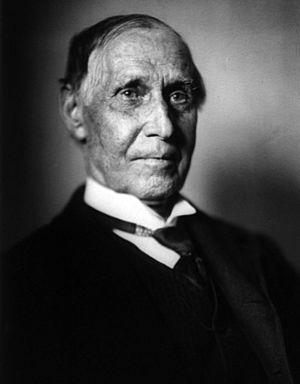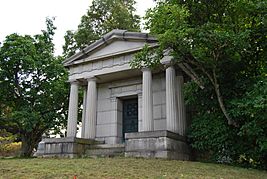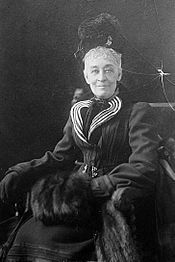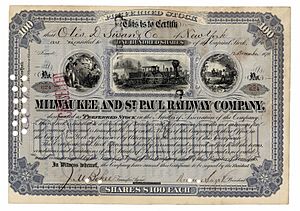Russell Sage facts for kids
Quick facts for kids
Russell Sage
|
|
|---|---|

Russell Sage in 1903
|
|
| Member of the U.S. House of Representatives from New York's 13th district |
|
| In office March 4, 1853 – March 3, 1857 |
|
| Preceded by | John L. Schoolcraft |
| Succeeded by | Abram B. Olin |
| Member of the Troy City Council | |
| In office 1841–1848 |
|
| Personal details | |
| Born | August 4, 1816 Verona, New York, U.S. |
| Died | July 22, 1906 (aged 89) New York City, New York, U.S |
| Resting place | Oakwood Cemetery, Troy, New York |
| Nationality | American |
| Political party | Whig (1841–1854) Opposition (1854–1858) |
| Spouses | |
| Profession | Businessman, socialite |
| Net worth | US$70 million (1906) |
| Signature | |
Russell Risley Sage (August 4, 1816 – July 22, 1906) was an American businessman and politician. He made a large fortune, especially from railroads. His second wife, Olivia Slocum Sage, inherited his money. She used it to help others, especially by supporting women's education. She started the Russell Sage Foundation in 1907 and Russell Sage College for women in 1916.
Contents
Early Life and Family Background
Russell Sage was born in Verona, New York, on August 4, 1816. He went to public school and worked on a farm until he was 15. He then became an errand boy in his brother Henry's grocery store in Troy, New York. Later, he owned parts of grocery stores in Troy from 1837 to 1857.
On January 23, 1840, Sage married Marie-Henrie Winne. They did not have any children. Marie-Henrie passed away on May 7, 1867. In 1869, Russell Sage married Olivia Slocum. She was ten years younger than him.
Russell Sage's Political Career
In 1841, Russell Sage was elected as an alderman in Troy. An alderman is a member of a city council. He served in this role until 1848. During this time, he also worked for seven years as the treasurer for Rensselaer County.
Sage was elected to the U.S. House of Representatives. He served from March 4, 1853, to March 3, 1857. He was a member of the Whig Party and later the Opposition Party. While in Congress, he was part of the Ways and Means Committee. Russell Sage was the first person in Congress to suggest that the government buy George Washington's home, Mount Vernon.
Russell Sage's Financial Success
After leaving politics, Sage moved to New York City. He became involved in the stock market, especially with options. He helped develop the market for stock options in the United States. He was even called the "Father of Puts and Calls."
In 1874, Sage bought a seat on the New York Stock Exchange. He became a well-known financier. He saw a big future in railroads and bought shares in many western railway companies. He was president or vice-president of some of these companies for twelve years. By selling these investments as smaller railroads joined larger ones, he became very rich.
Later in his life, he worked closely with Jay Gould. They managed several major railroads together, including the Wabash Railway and the Missouri Pacific Railroad. He was also a director for companies like Western Union (a telegraph company) and the elevated railroads in New York City. He was also a director of the Union Pacific Railroad, which built part of the transcontinental railroad. Through these investments, he made a huge fortune. He also served as a director and vice-president in several banks.
Assassination Attempt on Russell Sage
In 1891, a man named Henry L. Norcross came into Sage's office. Norcross had a bag of dynamite and demanded a large sum of money. Sage refused to pay. The dynamite exploded, killing Norcross. Sage was injured, and a clerk named William R. Laidlaw, Jr. was also badly hurt.
Laidlaw later sued Sage, saying that Sage had used him as a shield during the explosion. Laidlaw won money in court after four trials, but a higher court later overturned the decision. Sage never paid Laidlaw. Some people criticized Sage for not paying, especially because he was so wealthy.
Russell Sage's Legacy

When Russell Sage died in 1906, he left his entire fortune, about $70 million, to his wife, Olivia Slocum Sage. He was buried in a mausoleum at Oakwood Cemetery in Troy, New York.

Olivia Sage used a large part of the money she inherited for good causes. She created buildings and memorials in her husband's name. In 1907, she started the Russell Sage Foundation. This foundation helps improve social and living conditions. In 1916, she founded Russell Sage College in Troy, New York, which was a college for women. She also gave a lot of money to the Emma Willard School and Rensselaer Polytechnic Institute (RPI) in Troy.
During World War II, a ship called the Liberty ship SS Russell Sage was built and named in his honor.
See also
 In Spanish: Russell Sage para niños
In Spanish: Russell Sage para niños


